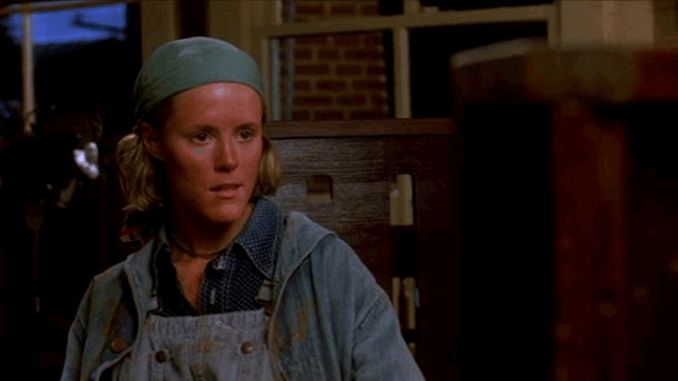
As Fried Green Tomatoes reaches its final scene, viewers are left with a sense of closure cloaked in mystery. Evelyn Couch, now transformed and confident, rushes into the nursing home only to find Ninny gone — a moment that briefly suggests loss. But then she steps outside into the garden and there, under a soft Southern sun, sits Ninny, alive, calm, and smiling.
What follows is a short, seemingly innocent conversation — but one that redefines the entire film.
The Unexpected Return
When Evelyn sees Ninny alive, her shock is palpable. It’s a moment where the audience exhales with relief — but the real intrigue is just beginning.
“You know, I might just move back to Whistle Stop,” Ninny says.
“But there’s nothing there. It’s all gone,” Evelyn replies.
And then the line that launches a thousand fan theories:
“Well maybe I am older than dirt, but there was a bee charmer there once, and she’s still around somewhere. If you ever see her, you tell her the secret’s safe with me.”
It’s not just a wistful remark. It’s a revelation. And it changes everything.
Was Ninny Really Idgie?
This final scene has fueled decades of debate. Is Ninny actually Idgie Threadgoode, telling Evelyn the story of her own youth through metaphor and misdirection? The film never confirms this outright — but it lays down enough breadcrumbs to make the idea deeply compelling.
-
Ninny knows intimate details of Idgie’s life — details only a participant could know.
-
She refers to Idgie in the third person throughout the film, but her connection seems too emotional, too personal to be secondhand.
-
Most tellingly, her final comment — “You tell her the secret’s safe with me” — is delivered with a wink, a smile, and a knowing look that defies explanation.
Whether Ninny is literally Idgie, or simply carrying her spirit and story forward, is left unresolved — and that’s the genius of it.

Narrative Closure vs. Emotional Openness
Cinematically, the film gives viewers emotional closure: Evelyn has grown, transformed, and formed a genuine connection. Ninny is alive and smiling. The bond between them is solidified.
But narratively, the film opens a door. The last scene reminds us that the past is never truly past — and that some stories are too beautiful to pin down with facts.
It invites viewers not to solve the mystery, but to live with it. Just as Evelyn must now carry the legacy of Ninny and Whistle Stop, so too must the audience carry the memory of what was and what might have been.
Evelyn’s Transformation, Sealed with Soil and Seeds
This final scene also marks the culmination of Evelyn’s arc. She’s no longer the timid, overlooked housewife of the film’s opening. She’s assertive, open-hearted, and willing to believe in something bigger than herself — in friendship, in legacy, in the possibility that stories hold deeper truths.
Ninny hands her a bag of flower seeds, symbolic of everything Evelyn has gained: growth, beauty, and the tools to keep the story alive. It’s not just a gift — it’s a torch being passed.
The Power of Ambiguous Endings
In an era of films obsessed with clear resolutions, Fried Green Tomatoes dares to end with a wink, a smile, and a question mark. And yet, it leaves us more satisfied than any spelled-out finale ever could.
Because, at its core, the film isn’t just about Idgie or Ruth, or even Evelyn and Ninny. It’s about how stories shape us, how friendship heals us, and how a life well-lived often defies the boundaries of truth and legend.
The last scene of Fried Green Tomatoes is not an ending — it’s a seed. It invites us to go back, rewatch, rethink, relive, and plant new meanings every time. And maybe, just maybe, to believe in bee charmers and secrets that endure.
